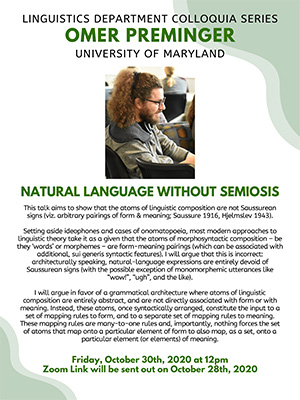Natural language without semiosis
Omer Preminger
University of Maryland
Friday, October 30, 2020
Noon
Zoom (email linguistics@rochester.edu for link)
This talk aims to show that the atoms of linguistic composition are not Saussurean signs (viz. arbitrary pairings of form and meaning; Saussure 1916, Hjelmslev 1943).
Setting aside ideophones and cases of onomatopoeia, most modern approaches to linguistic theory take it as a given that the atoms of morphosyntactic composition – be they ‘words’ or morphemes – are form- meaning pairings (which can be associated with additional, sui generis syntactic features). I will argue that this is incorrect: architecturally speaking, natural-language expressions are entirely devoid of Saussurean signs (with the possible exception of monomorphemic utterances like “wow!”, “ugh”, and the like).
I will argue in favor of a grammatical architecture where atoms of linguistic composition are entirely abstract, and are not directly associated with form or with meaning. Instead, these atoms, once syntactically arranged, constitute the input to a set of mapping rules to form, and to a separate set of mapping rules to meaning. These mapping rules are many-to-one rules and, importantly, nothing forces the set of atoms that map onto a particular element of form to also map, as a set, onto a particular element (or elements) of meaning. In fact, the input sets to form and to meaning can stand in all manner of misalignment, including what I term proper partial overlap, an illustration of which is given in (1), and an example of which is given in (2):
- abstract demonstration of proper partial overlap:
- SYNTAX: [x, [y, z]]
- SEMANTICS:
- {x} → A
- {y, z} → B (descriptively, we are used to calling B an “idiom”)
- MORPHO-PHONOLOGY:
- {x, y} → R (descriptively, we are used to calling R a “suppletive fusional exponent”)
- {z} → S
- concrete example of proper partial overlap:
- SYNTAX: [PAST, [GO, OFF]]
- SEMANTICS:
- {PAST} → “before now”
- {GO, OFF} → “explode”
- MORPHO-PHONOLOGY:
- {PAST, GO} → /wɛnt/
- {OFF} → /ɑf/
The expression in (2) is composed of smaller parts, both in terms of its semantics (“before now”, “explode”), and in terms of its morpho-phonology (/wɛnt/, /ɑf/). It would therefore be incorrect to claim that (2), as a whole, constitutes an ‘arbitrary’ pairing of form & meaning. At the same time, there is nothing else in (2) that constitutes a pairing of form & meaning, either – only pairings of abstract syntactic nodes with meaning (2.b.i‑ii), and separate, incommensurate pairings of abstract syntactic nodes with form (2.c.i‑ii). Thus, (2) involves no Saussurean signs whatsoever.
I will show that empirically, cases of proper partial overlap abound, as do other types of cases predicted by the proposed architecture. Lastly, I will argue that even those contemporary linguistic frameworks that distance themselves from outright Saussureanism, such as Distributed Morphology (Halle & Marantz 1993, 1994) and Nanosyntax (Starke 2009, Caha 2009, 2019), retain certain Saussurean vestiges that render them less explanatory than the current proposal.

